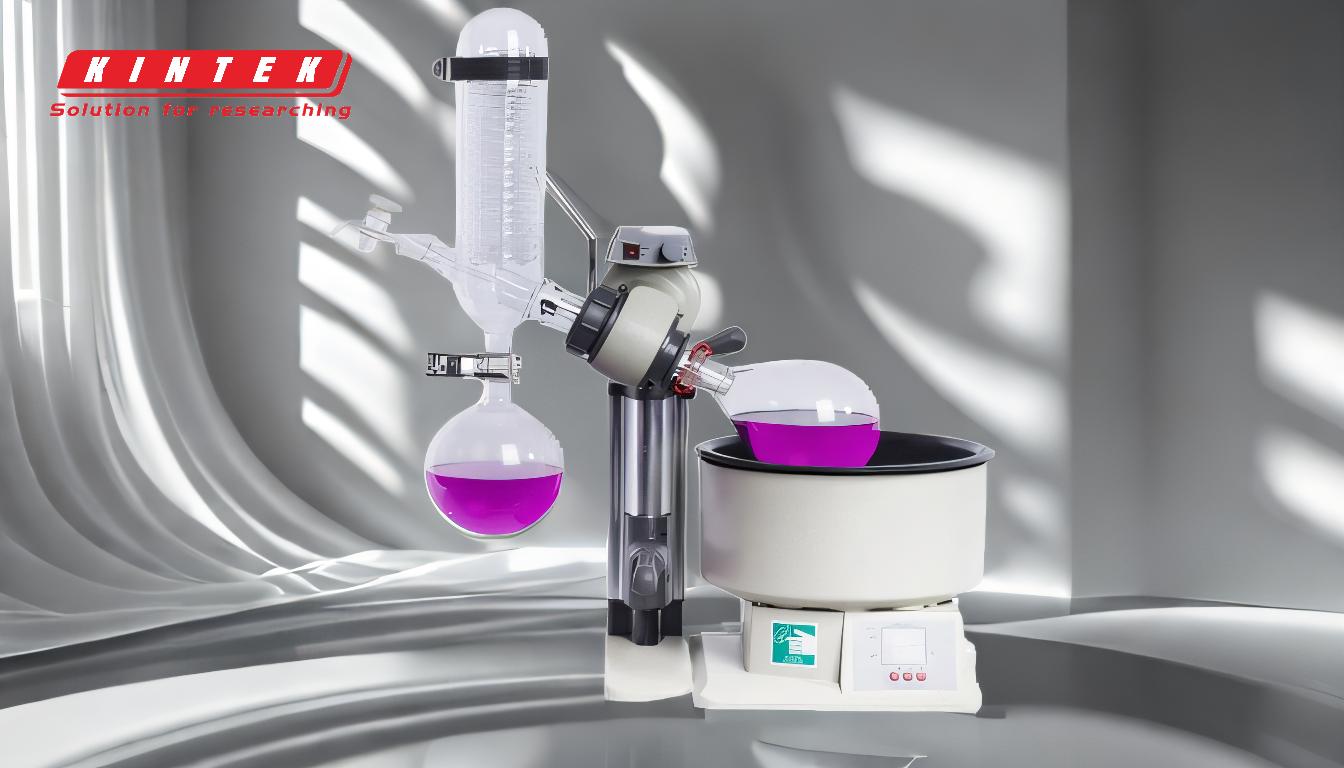A rotary evaporator, commonly known as a rotovap or rotavap, is a laboratory device designed to efficiently remove solvents from samples through evaporation under reduced pressure. It operates by rotating a flask containing the sample in a heated water bath, which increases the liquid's surface area and accelerates evaporation. The reduced pressure lowers the solvent's boiling point, enabling evaporation at lower temperatures. The solvent vapor is then condensed in a water-cooled condenser and collected in a separate flask, leaving behind a concentrated compound in the original flask. This method is widely used in chemistry, pharmaceuticals, and other industries for solvent recovery and sample concentration.
Key Points Explained:

-
Purpose and Function:
- The primary purpose of a rotary evaporator is to remove solvents from samples, leaving behind concentrated compounds.
- It achieves this through a combination of reduced pressure, heat, and mechanical rotation, which work together to facilitate efficient solvent evaporation.
-
Key Components:
- Rotating Flask: A round-bottomed flask that holds the sample solution. The rotation increases the liquid's surface area, enhancing evaporation.
- Heated Water Bath: Provides controlled heat to the rotating flask, aiding in the evaporation process.
- Vacuum Pump: Reduces the pressure inside the system, lowering the solvent's boiling point and enabling evaporation at lower temperatures.
- Condenser: Cools the solvent vapor, causing it to condense back into a liquid, which is then collected in a receiving flask.
-
Working Principle:
- Reduced Pressure: The vacuum pump lowers the pressure in the system, which decreases the solvent's boiling point, allowing it to evaporate at a lower temperature.
- Rotation: The rotating flask spreads the solvent as a thin film on the interior surface, increasing the surface area and speeding up evaporation.
- Evaporation and Condensation: The solvent evaporates due to the heat and reduced pressure, and the vapor travels to the condenser, where it is cooled and collected as a liquid.
-
Advantages:
- Efficiency: The combination of reduced pressure, heat, and rotation makes the process faster and more efficient than traditional evaporation methods.
- Gentle Evaporation: Lower temperatures reduce the risk of degrading heat-sensitive compounds.
- Solvent Recovery: The condensed solvent can be collected and reused, making the process economical and environmentally friendly.
-
Applications:
- Chemistry and Pharmaceuticals: Used for concentrating solutions, purifying compounds, and recovering solvents.
- Food and Beverage Industry: Employed in the extraction of flavors, fragrances, and essential oils.
- Environmental Testing: Utilized for concentrating samples for analysis, such as in water quality testing.
-
Considerations for Purchasers:
- Capacity: Choose a model with a flask size appropriate for your sample volumes.
- Vacuum Performance: Ensure the vacuum pump can achieve the necessary pressure reduction for your solvents.
- Temperature Control: Look for precise temperature control in the water bath to handle heat-sensitive materials.
- Build Quality: Opt for durable materials and reliable components to ensure longevity and consistent performance.
- Safety Features: Consider models with safety features such as automatic shut-off and pressure release valves.
In summary, a rotary evaporator is an essential tool in many laboratories, offering a reliable and efficient method for solvent removal and sample concentration. Its design and operation make it suitable for a wide range of applications, from chemical synthesis to environmental testing. When purchasing, it's important to consider factors such as capacity, vacuum performance, and safety features to ensure the device meets your specific needs.
Summary Table:
| Aspect | Details |
|---|---|
| Purpose | Removes solvents from samples, leaving concentrated compounds. |
| Key Components | Rotating flask, heated water bath, vacuum pump, condenser. |
| Working Principle | Reduced pressure lowers boiling point; rotation increases surface area. |
| Advantages | Efficient, gentle on heat-sensitive compounds, solvent recovery. |
| Applications | Chemistry, pharmaceuticals, food and beverage, environmental testing. |
| Purchase Considerations | Capacity, vacuum performance, temperature control, build quality, safety. |
Ready to enhance your lab’s efficiency with a rotary evaporator? Contact us today to find the perfect model for your needs!











